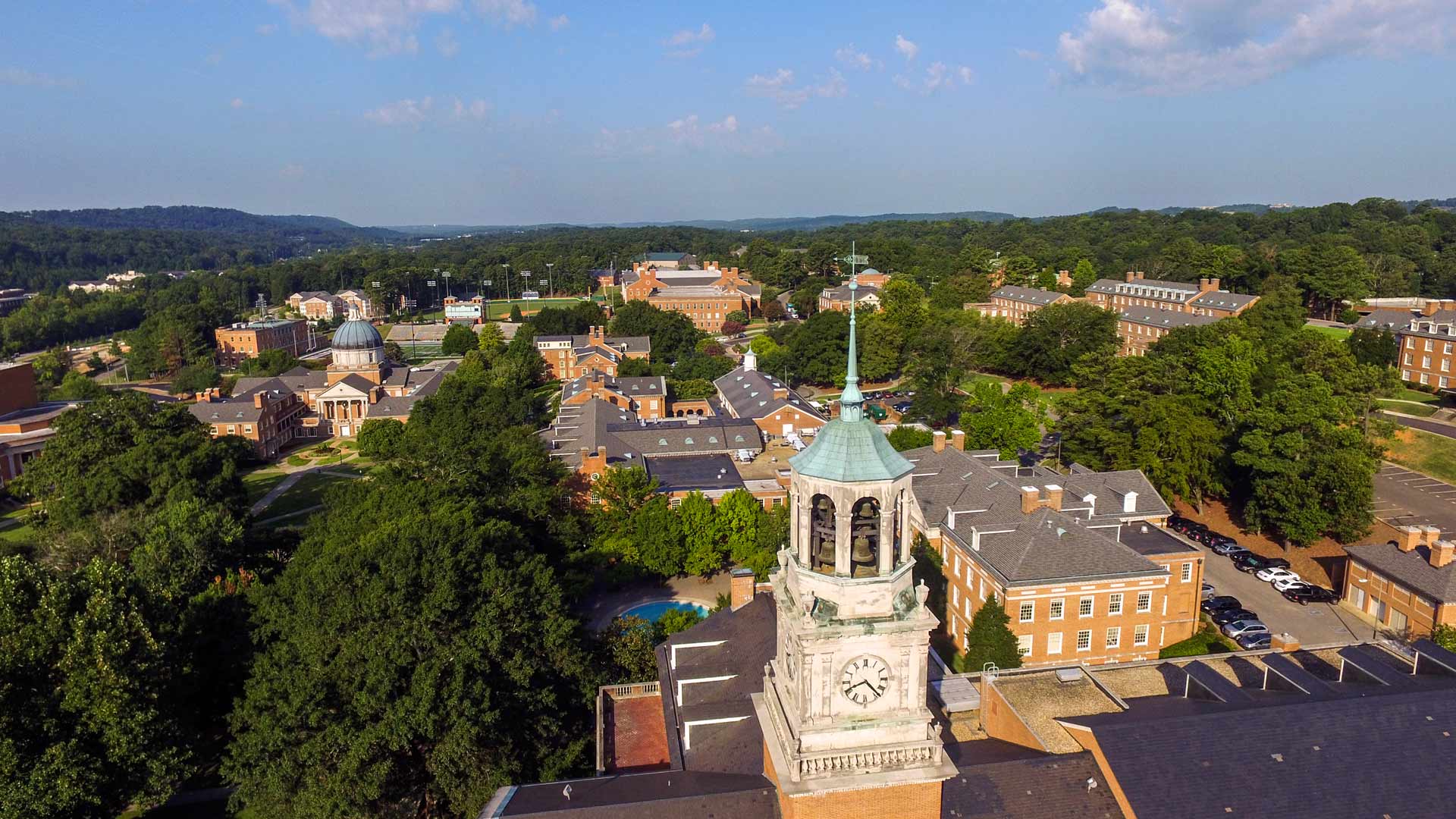Upcoming Events
November Food Drive
Saturday, November 1-20
The Department of Sustainability and School of Public Health have partnered with the Grace Klein Community to host a food drive supporting the FeedBHM food rescue initiative. Non-perishable donations may be placed in the green barrel located in the CHS lobby from Nov. 1-20. Together, we can make a difference!
3rd Annual Love Your Trees Day
Saturday, November 2
Learn about Homewood's native trees and how we can work together to keep the woods in Homewood!
Participants will hear from local tree experts, engage with members of the Homewood Environmental Commission, and enjoy fall weather, Hero Doughnuts and a cup of Domestique coffee while grabbing some tree swag.
Native trees will be given to participants upon completion of the workshop, so register today! Tree selection will occur during registration, with varieties available on a first-come, first-served basis. Please register for only one tree per Homewood property. If you select more than one tree, the Homewood Environmental Commission will choose one for you.
This is a family-friendly event, so bring the kids and let them learn how to plant their own tree!
Please note that you must attend the event in person to receive the tree!
Previous Events
Shades Creek Clean Up
On September 28, a group of Samford volunteers joined local community members for the Shades Creek Cleanup. Together, they dedicated time and effort to clear the creek banks, creating a safer and more beautiful environment for both wildlife and recreationists. Thank you to everyone involved for their commitment to sustainability and conservation.
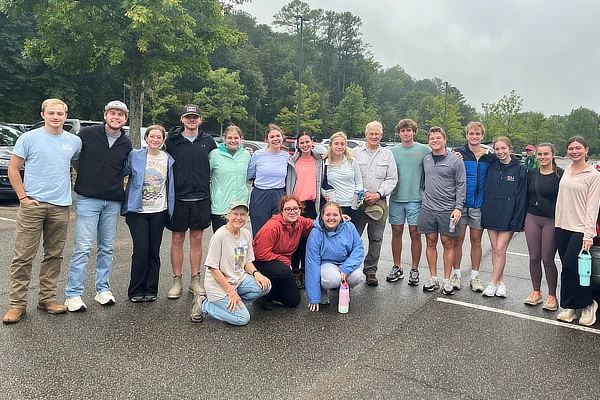
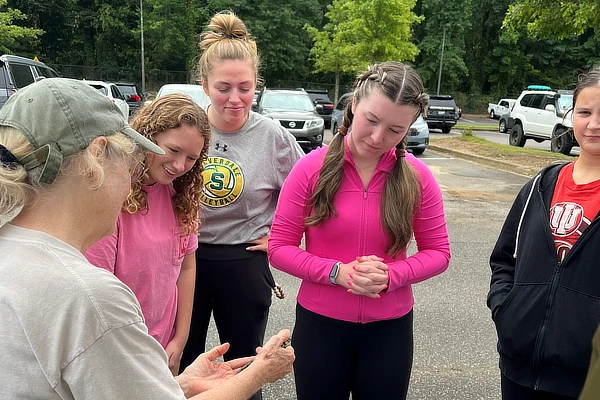
Spring and Fall Document Clean Out
Spring Clean Out - TBA
Electronics Recycling and Document Shredding trucks will be on campus this spring to allow you to safely dispose of your personal documents.
It’s also a great time to clean out those office file cabinets and securely shred sensitive documents!
Document Shredding
Employees and students may have up to five boxes of personal documents shredded at this time. If your department has a large number of boxes (more than 10), please contact lthoma14@samford.edu.
Please do not shred documents that are not of a sensitive nature that can be recycled. Old publications or public documents can be recycled, not shredded.
The company will not accept plastic or plastic bags of any kind. Paper bags and boxes are fine. Please remove all binder clips. Paperclips are fine for the shredder, but if they can be removed easily, they can be reused. Books and other bound documents will not be accepted unless they have been torn apart.
You will be asked to take your boxes with you after shredding. Please consider reusing your boxes.
Binders will not be accepted, but if you will remove the contents of the binder, the contents can be shredded. Please remove all plastic sheet covers.
As you review old documents, be sure that you are following the University’s retention schedule guidelines before records are shredded. The current policy, procedure, and retention schedule can be found in Section 1.27 on the Samford HR policy website.
Please discuss any historical-related content with the University Archives.
Electronics Recycling
There is a $10 charge (cash only) for hard drive shredding and for CRT monitor recycling. There is a $25 charge for LCD, Plasma, LED, and CRT TVs. All other items (see list below) can be recycled for FREE!
If you have Samford equipment you would like to recycle, please send an email to support@samford.edu. This will allow Technology Services to review their inventory records and confirm that your items are not on lease.
Accepted Items for E-Recycling:
- PCs including laptops
- Servers
- Cell phones & tablets
- Satellite & cable boxes
- Gaming systems & components
- Stereos & radios
- Switches & firewalls
- Printers & fax machines
- VCRs & DVD players
- Remote controls
- MP3 players
- A/C adapters & other cables
- LCD monitors (LCD TVs = $25 each)
- CRT monitors = $10 each (CRT TVs = $25 each)
- LCD, Plasma, LED and CRT TVs = $25 each
- Ink & toner cartridges
- Rechargeable batteries
- Hard drives including external = $10 each
- Speakers
- Cameras
- Modems & routers
- CD players
- Appliances
- Consumer electronics
- Battery backups
- Keyboards & mice
- …and other similar items
Recycling
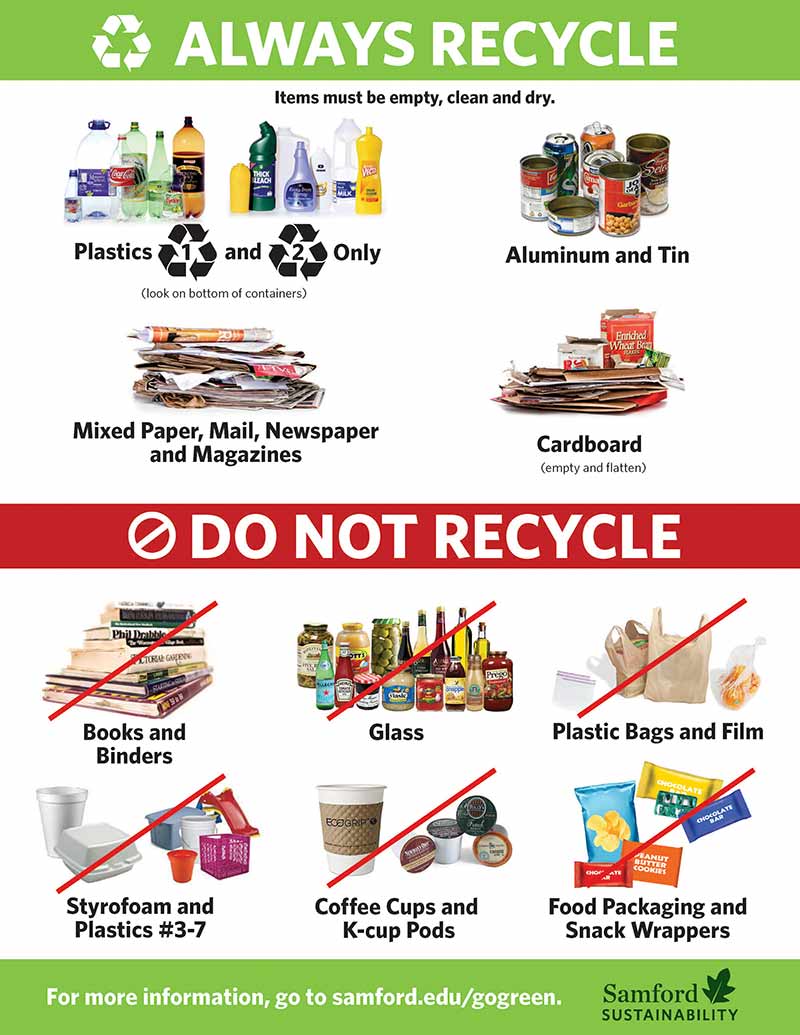
Locations
Glass Recycling
You can recycle empty, clean and dry glass at any Target store.
Green Skies Tree Planting
Samford University is pleased to partner with the Homewood Environmental Commission, the Birmingham Botanical Gardens and others for the annual Green Skies Tree Planting.
Please consider joining us in November to plant 200 tree seedlings in Homewood.
Volunteers will help with planting and mulching the small native trees. Other opportunities include removing invasive plant species and general clean-up. Some tools will be available, but you may want to bring your own gloves, a favorite shovel and/or rake.
Motivational snacks will be provided, and small native trees will be available for purchase!
For more information, please contact Anita Morgan at (205) 726-4674 or Amorga13@samford.edu.
Infrastructure Initiatives
Samford University’s picturesque campus is a key part of each student’s and employee’s experience. Maintaining our buildings, facilities and grounds in the most efficient manner is a direct reflection of our commitment to students and employees and to the academic and research activities that take place on our campus.
Samford has entered a multi-year, multi-phased partnership with Johnson Controls, Inc., a global leader in the manufacture and promotion of emergency efficient technologies.
Together, Samford and JCI have created a comprehensive campus infrastructure improvement program to improve the instructional atmosphere. The program supports a broader campus master plan that is being implemented. Through this program, Samford can implement necessary infrastructure and efficiency improvements across campus, generate significant energy savings while reducing our carbon footprint by more than 15,000 tons, decreasing water consumption on campus by more than 20 million gallons and promoting financial stability by using directed savings to fully fund the initiatives. The plan is expected to generate more than $1.65 million in savings annually.
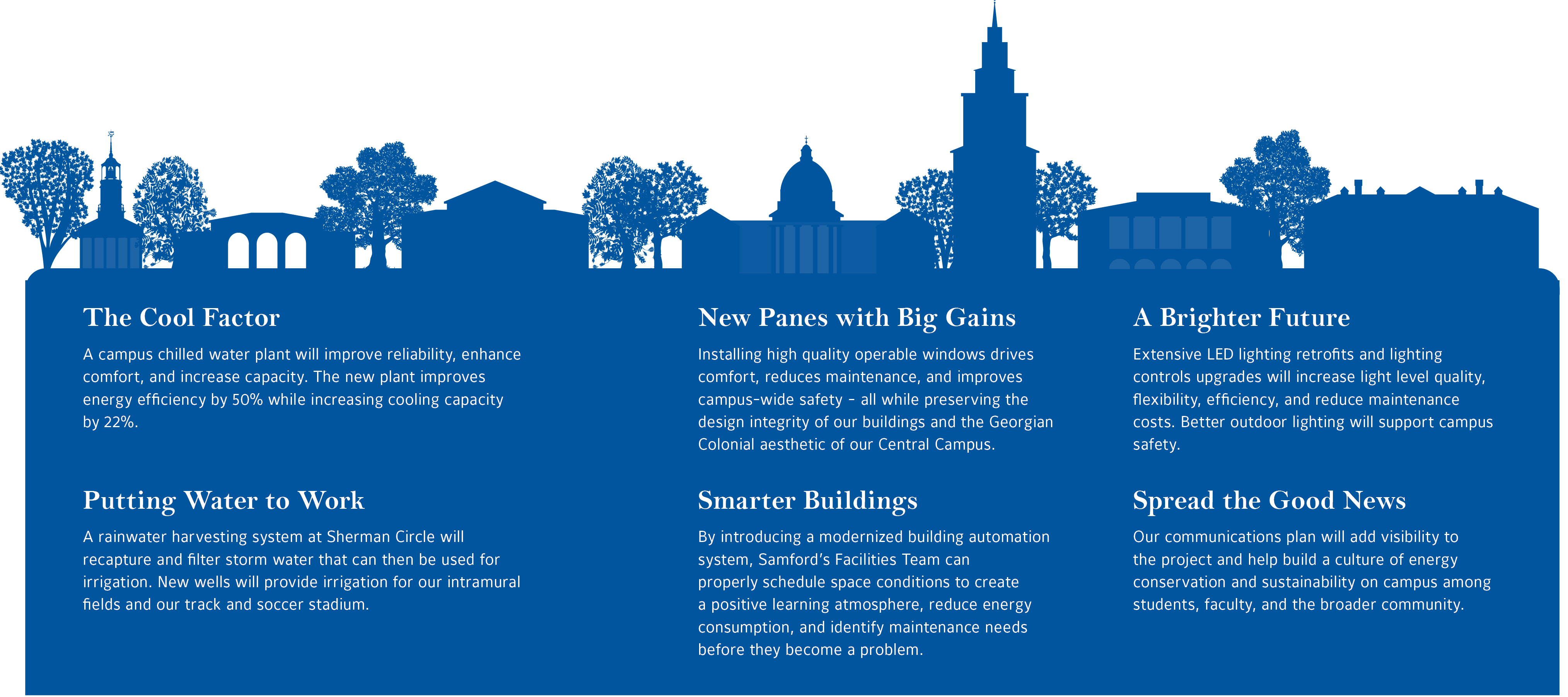
Recent Projects
Modern Building Automation Systems
- New wiring and thermostats have been installed to introduce modern building automation systems campus-wide. These upgrades will allow us to reduce energy consumption and identify HVAC maintenance needs remotely before they become a problem.
Lighting Upgrades
- Extensive LED lighting retrofits and lighting controls have been installed to increase light level quality and reduce maintenance costs, as well as to support campus safety.
Sanitary Fixture Upgrades
- Sanitary fixtures have been replaced in most buildings and we upgraded shower heads campus-wide.
Other Projects
- Construction of a new chilled water plant was completed in April 2017. This new plant will improve energy efficiency by 50 percent and increase cooling capacity by 22 percent.
- Exterior doors received new weather stripping, sealant and door sweeps that will reduce air infiltration. Some windows received weather stripping and sealant. Openings around piping, electrical penetrations and other blank openings have been sealed with caulk.
- Energy efficient windows were installed in Burns and Chapman Halls, Dwight Beeson Hall, Brooks Hall, Orlean Beeson Hall, Buchanan Hall, Samford Hall and Smith and Vail Residence Halls.
- Spray insulation was added to Divinity Hall’s attic.
Campus Initiatives
Custodial
Our custodial provider follows a Green to Clean program, which incorporates environmentally friendly chemicals, equipment, and supplies into the cleaning process. The custodial staff has also been trained in utilizing environmentally friendly processes, supplies, and equipment. Processes include water usage and environmental awareness while the equipment and supplies range from aerosols to vacuums.
Facilities Management
The installation of new boiler and chiller systems has been a crucial step in increasing the energy efficiency of the campus. Old boiler systems are being decommissioned. In addition, the HVAC controls in each building have been retrofitted.
Cleaning and “teardown” of HVAC equipment and filtering systems is scheduled regularly to improve operating efficiencies. When old lighting equipment has failed, new fixture technologies are being installed with high efficiency lamps and ballasts. All new facilities are outfitted with high efficiency pumps, air handling units, water heating, low flow plumbing equipment and Energy Star labeled appliances.
Food Services
Our food service provider has long purchased available produce locally. This supports local farmers and also cuts down on the fuel used for transporting produce over long distances.
Landscaping Services
Landscape Services has integrated environmentally friendly practices throughout the last several years. This includes discontinuing use of atrozine and increasing mulching activities across campus.
Residence Life
The Residence Life staff helps new residents recycle materials on Move-in Day.
During move out, Residence Life gathers donations for local charities.
Academics
Samford University offers a Master of Science in Environmental Management (MSEM), as well as a dual degree in law and environmental management (JD/MSEM). The Environmental Studies minor was recently introduced as a part of the Geography department.
Master of Science in Environmental Management
The master of science in environmental management (M.S.E.M.) is a 36-credit, non-thesis program conducted by the Department of Biological and Environmental Sciences. It directs working professionals through a collection of courses to prepare them for the decision-making processes of the ever-increasing demands of environmental regulatory compliance.
Environmental Science Major
Students majoring in Environmental Science will choose from one of three tracks, depending on their academic goals. Each track emphasizes training in different areas, with broad flexibility in electives allowing the student to tailor the major to his/her specific interests. The major is designed to prepare students for a wide range of careers, and graduate and professional programs.
Environmental Studies Minor
Environmental studies is an interdisciplinary field that explores the relationship between humans and the environment, in the interest of solving complex problems. Students study the built and natural environment, and explain about human views and interactions with nature.

